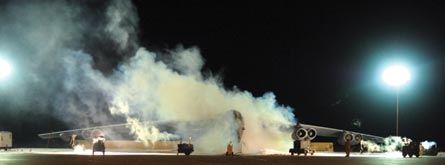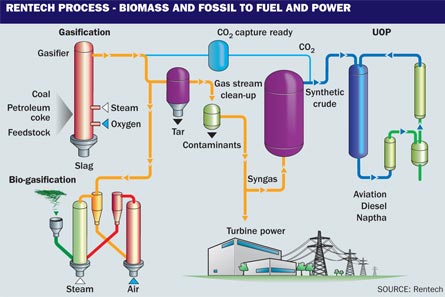Synthetic jet fuel has proven itself to the US Air Force, which is confident it will easily meet a 2011 goal by certificating its entire turbine fleet to burn blended fuel, half of which will be converted from coal or natural gas.
Fuels from the Fischer-Tropsch process so impressed the USAF that hydrotreated renewable jet (HRJ) fuels are likely to have an easier passage, with HRJ testing set to take place on only three "pathfinder" airframes. And fuel producers are pleased to see certificating body ASTM International showing similar confidence as its turbine fuel specification comes up for revision to include biofuels made from a growing assortment of feedstocks.
Biomass can be gasified and converted to fuel through the Fischer-Tropsch process as well, but the USAF has focused on coal-to-liquids to confirm that chemically identical fuels perform alike no matter what the raw material is. Almost anything carbon-based can be squeezed, heated and nudged into a hydrocarbon and then into fuel.
A major question now is whether private industry will make capital investments during a recession to help the USAF meet another high-profile goal for synthetic paraffinic kerosene (SPK). "Real progress means being able to make large-scale, cost-effective purchases of alternative fuels," says USAF undersecretary Erin Conaton. "We need help from industry leaders so that by our 2016 goal year, we can competitively acquire half of our domestic aviation fuel requirement via an alternative fuel blend." This year the air force will spend $6.7 billion on aviation fuel, she says. The USAF accounts for more than half the consumption of oil by all US government agencies.
 The US Air Force is confident that its entire turbine fleet will be certificated to burn blended fuel by 2011. Picture: USAF/Airman 1st Class Christopher Boitz |
|---|
LOW-HANGING FRUIT
Industry will be ready in 2016, predicts Tim Edwards, senior chemical engineer in the Fuels Branch at the Air Force Research Laboratory's Propulsion Directorate/Turbine Engine Division. "Our job is to help create the market," he says. The USAF has had success with 50/50 Fischer-Tropsch blends, which he says was "low-hanging fruit. We're looking ahead to 100% on the research side."
Edwards is based at Wright-Patterson AFB in Ohio along with the Alternative Fuels Certification Office, where Betty Rodriguez is chief engineer. "We tell the lab what we want it to look like and those guys tweak it so it looks just like JP-8," she says, adding that it is always exciting when the fuel meets performance specifications even if this is unsurprising. Rodriguez serves as USAF certification and qualification representative to CAAFI, the Commercial Aviation Alternative Fuels Initiative, which promotes and links efforts across governments and industries.
CAAFI's certification team has met in preparation for the 27 June-1 July meeting of ASTM International Committee D02 on petroleum products and lubricants in Kansas City, Missouri. There, a ballot to revise ASTM D7566-09 to allow HRJ production will be discussed by Subcommittee J's 160 members, who received the ballot three weeks ago. These blending components will be called "hydroprocessed SPK from fatty acid esters or free fatty acids", says the ballot, which may pass both committees and be published by December.
That milestone cannot be understated, notes Richard Altman, CAAFI executive director. "The initial ballot, based upon last year's experience, is very significant in clarifying and establishing a path to resolve any remaining issues by the December meeting," Altman says. He refers to approval last June and September publication that allows Fischer-Tropsch production by any qualified producer.
A new specification is a floodgate, says Robert Freerks, a member of Subcommittee J and director of product development for Rentech. Production of its 40/60 blend of "RenJet" complied with ASTM D7566-09 (with final upgrading under a proprietary process of UOP, a Honeywell company) and powered a 30 April flight of a United Airlines Airbus A319.
A December agreement lines up 13 airlines to receive SPK made in Natchez, Mississippi, where Rentech plans to make 950 million litres (250 million USgal) of chemical and fuel products each year.
"We need a long-term agreement to get financing for major projects," says Freerks. "For the airlines to have an off-tank agreement for jet fuel it had to meet Federal Aviation Administration requirements and the FAA says it has to be certified by ASTM."
RESEARCH
It would not have happened without the USAF, Freerks adds, "or without thousands of hours of research by engine and airframe manufacturers to test this fuel and make sure it is fit for purpose. There was also a lot of help from Sasol, which has been producing this fuel for years."
"They're sharp," agrees Edwards, praising the 34,000-employee South African energy conglomerate and its pioneering Fischer-Tropsch process. After seven years of effort, production of Sasol's 50/50 gas-to-liquids blend earned approval in 1999 from the Aviation Fuels Committee and the UK Ministry of Defence, and later by ASTM. Its 100% SPK was included on 9 April 2008 in Defence Standard 91-91, which is referenced by ASTM in its own standards.
Sasol's fuel can only be made at its facility in Sasolburg. "Part of our effort is, how would you do that in a generic sense?" says Edwards, who would appreciate the scientific certainty he works with on the underlying science, which Jeffrey Braun puts to use as director of the USAF Alternative Fuels Certification Office.
A purchase of 1.5 million litres of Sasol's fuel in July 2008 is powering the final four USAF test flights before the entire fleet is certificated for 50/50 blends. "The three aircraft we have yet to fly are the [General Atomics] Reaper, [Northrop Grumman] Global Hawk and [Sikorsky] Black Hawk helicopter," says Braun.
"Four aircraft that have flown but the paperwork isn't ready are the [Lockheed Martin] F-16, [Beechcraft] T-6, [Boeing] KC-135 and [Northrop Grumman] B-2." Not all platforms needed testing, he notes, since many are derivatives or have civil counterparts that are already approved.
The final platform to meet USAF's 2011 certification goal will be the Reaper, because the unmanned air vehicles are in such high demand. "When we finally do get our hands on that item we're not only going to do the Fischer-Tropsch certification, but the biomass specs with the HRJ," says Braun.
"Our mandate was to go out there and do a fleetwide certification, so we have literally looked at every platform in the air force," he says, but since the Fischer-Tropsch fuels and new HRJ (or bio-SPK) fuels are so chemically similar to what they have already tested, "we've put together a much more aggressive certification method for these biomass fuels. We're not going to touch every platform. We're only going to look at the fleet representatives or the most complicated airframes."
The Boeing C-17 represents mobility aircraft, "and it burns the most fuel in the air force", he notes. The Lockheed Martin F-22 and Global Hawk round out the "pathfinder" list.
Braun and Edwards were panellists at the USAF Energy Forum, subtitled "A New Culture: Energy as an Operations Enabler" in Washington DC in May. Undersecretary Conaton remarked on HRJ testing to every senior air force officer and leaders in public and private alternative fuel research and development.
"In March we flew a [Fairchild] A-10 Thunderbolt II powered by a blend of biomass-derived and conventional JP-8 fuel. We are quite proud of this accomplishment. In fact, President Obama highlighted this first-ever successful biofuel-powered test flight during his speech on Energy Security at Joint Base Andrews," she says.
USAF Chief of Staff Gen Norton Schwartz asked for enthusiastic acceptance of the challenging road the air force started on: "Energy management demands the continuous infusion of new information, developments and cutting-edge technology. It also requires buy-in at every level in the air force."
Besides a high price per litre without economy of scale, Fischer-Tropsch emits high levels of carbon dioxide. Carbon capture and storage needs to prove itself and accompany each facility to equal fossil fuel emissions, and biomass feedstocks bring that footprint lower.
LOWER FREEZING TEMPERATURE
SPK from Fischer-Tropsch has a lower freezing temperature and burns cleaner, Braun notes. The only problem comes with blends somewhere beyond 50%, when engine seals dry out. "The 50/50 blend is what's required to achieve the level of aromatics to get the nitrile swell," Braun says.
At the Qatar Science and Technology Park in Doha, Shell is working with Airbus, Qatar Airways, Qatar Petroleum and Rolls-Royce to solve that problem for legacy aircraft and the next generation.
"How much seal swell is actually required for a safe operation without leaks in a legacy aircraft?" asks Paul Bogers, Shell's aviation technology manager, adding: "Can we find elastomeric materials that are less prone to seal swell, or require less swell?"
Bogers says universities around the world are brought in to look beyond fuel production, even as Shell builds new partnerships in China and the new Pearl facility in Qatar, which aims to be the world's largest gas-to-liquids facility after it opens in late 2011.
"It's chemistry on an absolutely amazing scale," he says.

Source: Flight International
















